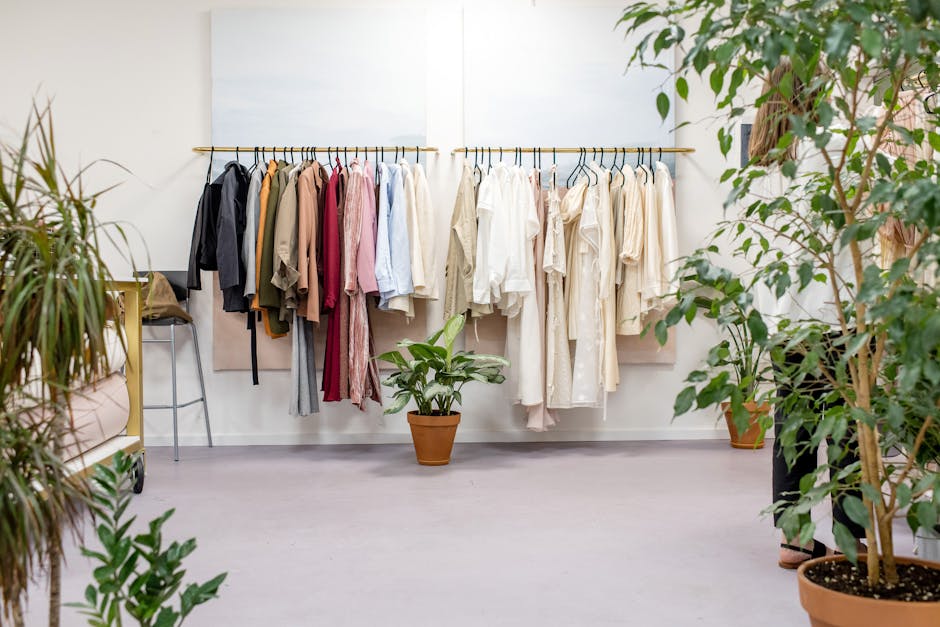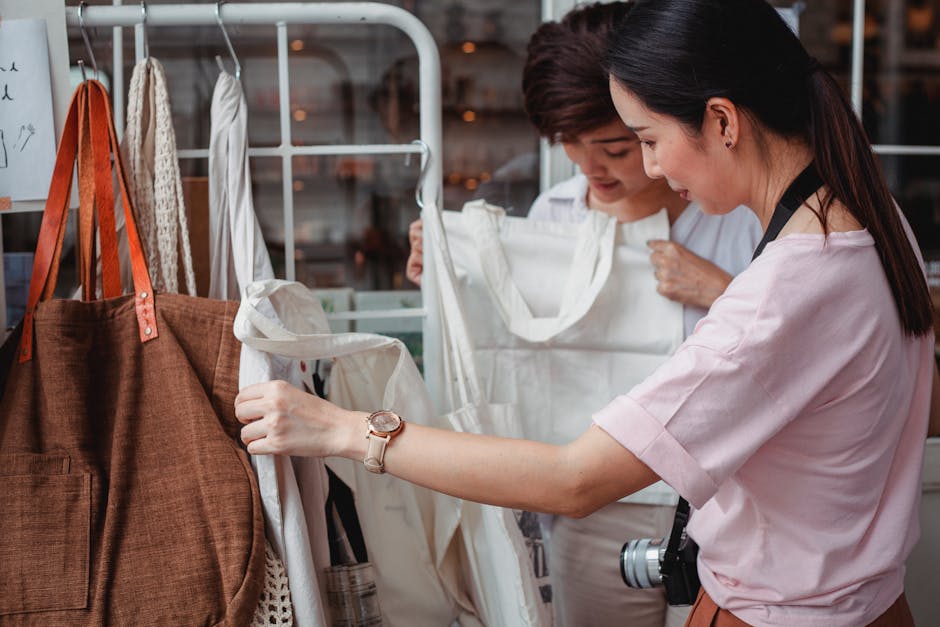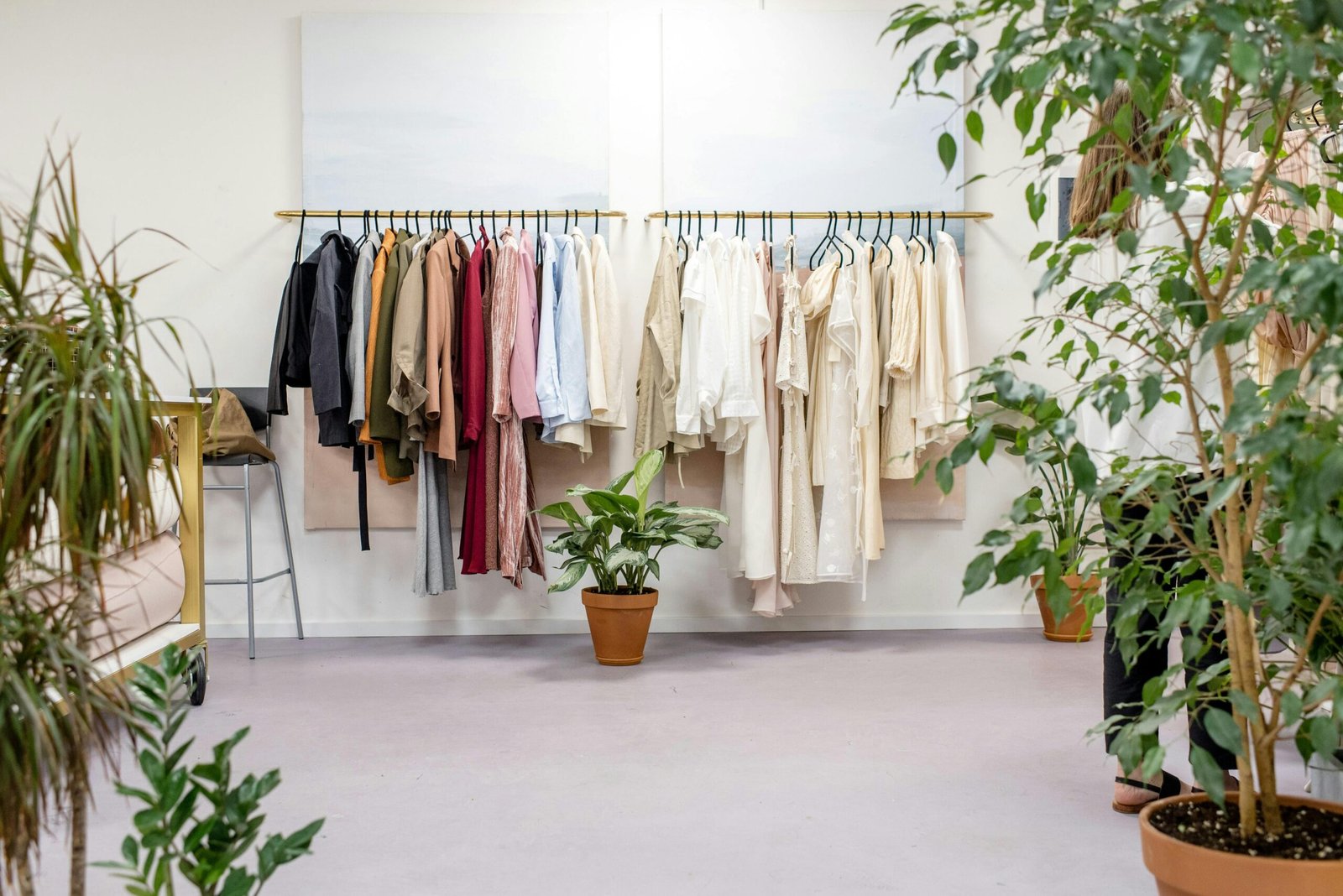Introduction
When we speak of ‘sustainable fashion’, we’re essentially talking about a conscientious approach to apparel that values design longevity, considers environmental implications, and places a premium on human rights. This progressive take on clothing extends beyond the mere outfit that swathes us; it’s an ideology intertwined with environmental empathy.
Today, as wildfires roar and glaciers melt, our planet’s plea for help reverberates a bit more loudly each day. And it’s high time we’ve turned a collective ear in its direction. One answer to that rallying cry? Sustainable fashion.
Indeed, sustainable fashion is not only a mere trend du jour, it has become an imperative, a change that needs to reverberate through our closets and resonate in our future shopping lists. In this article, we’re digging deep into this eco-conscious revolution. We’ll delve into what sets sustainable fashion apart from the fast-fashion frenzy, introduce eco-friendly clothing alternatives, and explore how to select ethical brands. Moreover, we’ll talk about greener trends, making your wardrobe last, and, perhaps most importantly, the individual and collective impact of such fashion choices. Buckle up for a style ride that shrugs off vanity and embraces the environment. It’s not just about looking good, but about doing good, too. Join us as we knit together an eco-friendly wardrobe that not just lasts, but also cares.

Understanding Sustainable Fashion
Sustainable fashion is a term gaining momentum in our modern discourse, but what does it truly mean, and why is it important? This section aims to unravel these terms and illuminate their significance.
What is Sustainable Fashion?
On a fundamental level, sustainable fashion refers to clothes, shoes, accessories and all other fashion items that are designed, sourced, manufactured, and marketed while being conscious of their environmental and socio-economic impacts. Imagine a salad bowl, the ingredients being:
- Respect for people
- Conservation of the ecosystem
- Ethical sourcing and transparency
The Importance of Sustainable Fashion
In the chaotic reality of today’s world, the need for sustainable fashion increasingly becomes more urgent. The fashion industry, especially fast fashion, contributes significantly to CO2 emissions, a major factor in climate change. However, sustainable fashion serves as a force for change, aiming to mitigate these poor environmental practices. Key practices include:
- Using organic materials that require less intensive farming
- Providing fair wages for workers
- Balancing of style and social responsibility
Practical Examples of Sustainable Fashion
To visualise sustainable fashion better, consider these examples:
- A t-shirt made from 100% organic cotton, grown without harmful pesticides and dyed using non-toxic colors.
- Companies that ensure fair trade agreements, meaning workers receive a fair payment and have decent working conditions.
These examples represent the many practices that make up the beautiful complexity of sustainable fashion.
Harnessing the Power of Fashion
Understanding the importance of sustainable fashion not only helps us appreciate the industry’s power to make us look and feel great, but also highlights its potential to positively impact our world. By embracing sustainable fashion practices, we can become stewards of our planet, making a difference one outfit at a time.

Understanding Fast Fashion
Fast fashion has undoubtedly become a significant player in our consumer-driven society. This term refers to the mass production of inexpensive clothing that replicates the latest styles and trends. However, this sector of the fashion industry presents several problems.
The Cycle of Fast Fashion
Fast fashion items are designed with a short lifespan in mind—meant for wear for a short period, then to be discarded as styles and trends change. Though this provides many with a convenient way to keep up with fashion trends affordably, the cost to the environment is significant.
Environmental Impact of Fast Fashion
The fast fashion industry exerts a heavy toll on our planet:
- Water Consumption: The fashion industry, particularly fast fashion, is the second-largest consumer of water worldwide.
- Carbon Emissions: Fast fashion contributes to 10% of humanity’s carbon emissions.
- Non-biodegradable Materials: Fast fashion often uses synthetic, non-biodegradable materials like polyester, which take up to 200 years to decompose in landfills.
- Pollution from Dyeing Process: Dyeing processes can pollute water bodies with harmful chemicals.
An exemplary case of the environmental impact of fast fashion is the drying up of the Aral Sea in Central Asia due to intense cotton farming for the fashion industry. This has resulted in devastating environmental and community consequences.
Social Issues in the Fast Fashion Sector
Additionally to environmental concerns, the rate of fast fashion production leads to social issues:
- Poor Working Conditions: Workers in this industry regularly face subpar working conditions.
- Inadequate Pay: These workers also often receive inadequate compensation for their work.
- Human Rights Violations: Violations of workers’ rights are not uncommon, as seen in the 2013 Rana Plaza collapse in Bangladesh, which resulted in over 1,000 garment worker deaths.
Making the Shift to Sustainable Fashion
Acknowledging these problems inherent in fast fashion is the first step toward changes in this industry. It emphasizes the urgent need to shift toward more sustainable fashion choices. We can make a difference, and it starts with understanding the environmental cost of our fashion selections. We can—and should—choose better, for the sake of both our planet and future generations.

What Makes Fashion Sustainable
Making a fashion choice sustainable involves more than just selecting an eco-friendly fabric; it’s a multi-faceted approach that extends beyond the manufacturing process. Specific factors contribute towards sustainable fashion and shape its definition – let’s take a look at some of these.
The first and perhaps most obvious factor is the use of materials that have a low environmental impact. These may be organic, recycled or renewable fabrics, dyed using processes that pollute less. But materials alone can’t define sustainable fashion.
Equally important is the ethical sourcing and manufacturing of the clothes. This implies fair trade practices, ensuring all those involved in the production process are paid decent wages, are working under safe conditions, and, crucially, are not child laborers. These notably ethical practices cultivate sustainability in the fashion industry by fostering social equity and driving positive change.
Next up – durability. Sustainable fashion isn’t about catering to the impulse of seasonal trends. It’s about creating quality garments that stand the test of time and can be worn season after season, year after year. When a piece lasts longer, the frequency of buying new clothing decreases, meaning less waste and less strain on resources.
Moreover, sustainable fashion carries the concept of transparency. It urges brands to be open about their manufacturing processes, the materials used, and the working conditions in their factories. It is about making it easy for consumers to make informed choices, empowering them to become an active part of the solution.
Lastly, there is the end-of-life aspect. How the life of a garment ends significantly impacts its sustainability factor. Clothes that are recyclable or biodegradable, reducing the waste sent to landfill, carry the essence of true sustainable fashion.
All these factors – the materials used, ethical sourcing and manufacturing, quality and durability, transparency, and end-of-life management – contribute to making fashion sustainable. They benefit not only the industry by creating an ethical and sustainable supply chain but also the environment by reducing pollution, waste, and resource use. It is the harmony of all these elements that makes fashion truly sustainable.

Eco-Friendly Clothing Alternatives
In the quest towards a more sustainable lifestyle, introducing eco-friendly clothing to your wardrobe represents a monumental stride forward. This section provides an overview of these clothing alternatives, illustrating the popular materials in their production, and showcasing examples of brands paving the path toward green fashion.
Eco-friendly clothing primarily consists of attire made from sustainable, organic, or recycled materials. Each material carries its own unique environmental benefits. For instance, organic cotton is free of harmful pesticides and chemicals that would otherwise pervade both the ecosystem and your skin. Hemp fabric is renowned for its durability and biodegradability, whereas recycled polyester utilizes post-consumer waste, preventing it from reaching our landfills. Bamboo, another intriguing choice, is fast-growing and requires only minimal water and no pesticides to produce.
But what use can these materials be if they are not converted into appealing garments? Here, several trailblazing brands come into the picture. Patagonia, for instance, embraces recycled polyester for a significant portion of their products while pioneering repair and reuse discussions. Everlane, another example, emphasizes transparency and ethical factories, alongside its commitment to using organic cotton. By supporting such brands, you both celebrate and propagate their sustainable mandates.
Making a transition to eco-friendly clothing alternatives doesn’t require a total wardrobe overhaul immediately. You can start by making informed decisions on small items, and progressively embrace slow fashion. Remember, each individual’s move towards a green wardrobe contributes to the larger journey of fashion sustainability.

Choosing Ethical Fashion Brands
An ethical fashion brand is one that makes conscious efforts to reduce harm and exploitation in its manufacturing process and supply-chain; this ranges from fair trade practices to providing safe working conditions and fair wages. Supporting ethical fashion brands is crucial as it helps foster a healthier, more transparent fashion industry and promotes social justice for the communities involved in production.
Some popular ethical fashion brands which are spotlighted for their commitment to both sustainability and style include:
-
Patagonia: Known for their outdoor clothing line, Patagonia is extensively committed to ethical practices. They use recycled, organic materials and ensure fair-trade practices.
-
Everlane: This brand is acclaimed for its transparency in cost and labor. Everlane offers a wide array of minimalist-styled clothing manufactured in ethical factories.
-
People Tree: A pioneer in sustainable Fair Trade fashion, People Tree’s garments are made to the highest ethical standards from start to finish.
-
Eileen Fisher: With a keen emphasis on simplicity and sustainability, Eileen Fisher is highly dedicated to eco-conscious production. They prioritize organic materials and recycling.
-
Alternativ Apparel: Known for their soft and durable basics, Alternative Apparel makes 80% of their garments with sustainable materials and processes.
By choosing these brands or ones like them, we not only get to enjoy high-quality, stylish garments, but also support a greater cause – a sustainable and ethical future for fashion.

Green Fashion Trends
Fashion isn’t only about owning the latest styles or the most high-end designer labels. Recently, it’s also about making conscientious decisions that are green and ethical. Let’s delve into the most attractive part of sustainable fashion – the green trends that are ruling the roost.
‘Green’ fashion promotes an eco-friendly lifestyle by using organic materials, optimal manufacturing processes, minimal packaging and fair-trade practices. Recently, these trends have not just bloomed but thrived, catalyzing the sustainable fashion movement massively.
One of the hottest trends is garment upcycling, or creatively reusing clothing or fabric to create high quality, desirable items. By breathing new life into old materials, upcycling circumvents the need for new fabric production, saving water, energy and reducing emissions.
Biomaterial fashion is another upcoming trend, where clothes are crafted from bioengineered textiles. Algae, corn, mushrooms, and other natural elements are being used to make materials for clothes. These biomaterials decompose naturally and efficiently, unlike synthetic fibers which can take hundreds of years to break down in landfills.
Focus on vegan fashion is also at an all-time high. More designers are shunning animal-derived materials in favor of organic cotton, hemp, or innovative materials like Pinatex (pineapple leather), thereby not causing harm to animals or high carbon emissions.
So, how about incorporating these trends into your wardrobe? Opt for upcycled apparel for your next shopping spree, or choose biomaterial clothes for a change. When buying leather or wool, look for vegan alternatives. By doing so, you not only become a trendsetter but also contribute to keeping our planet greener. You could consider this your fashion-forward commitment to the environment!

Making Your Wardrobe Last Longer
Your wardrobe should be a testament to your persona: unique, well-crafted, and enduring. Creating a wardrobe that lasts is not only an excellent step towards sustainable fashion but also saves you money and time in the long run. This is an area where frugality meets sustainability with style.
Maintenance for Longevity
First on the agenda is maintaining your clothes to ensure their longevity. Simple actions can make a significant difference, such as:
- Washing your clothes less frequently
- Avoiding harsh detergents
- Opting for air-drying instead of a tumble dryer
Preservation Strategy
Proper storage and rotation of your fashion items are essential for preservation:
- Fold heavy sweaters on a shelf instead of hanging them to maintain their shape.
- Store leather goods with care
- Rotate clothes to prevent the same items from wearing out too quickly.
- Use mothballs and appropriate storage to protect items like that beloved autumn sweater from pests.
Quality Over Quantity
Purchasing with a keen eye for quality over quantity is a smart long-term investment:
- Choose items made from high-quality, durable materials.
- Despite their higher initial cost, the longevity of these quality products more than compensates over time.
Recreate and Recycle
Giving new life to your fashion items could involve:
- Repurposing an old pair of jeans into shorts, or a fashionable tote for groceries.
- When repurposing isn’t an option, opt for recycling. Many brands now offer take-back programs for used clothes.
Creating a long-lasting wardrobe is about a shift in mentality from ‘fast fashion-consumerism’ to ‘sustainable-fanaticism.’ Enjoy your favorite fabrics, cherish their charm, and make them last. This is sustainable fashion at its finest.

The Impact of Your Choices
Every choice we make is like a small ripple in the grand scheme of life, sometimes it’s barely noticeable, yet other times, it can create waves of change. The exact same principle applies to our fashion preferences. Everyone’s daily choices about what, when, and from whom to buy clothing have a tremendous impact on the world, whether we realize it or not.
So, how exactly does choosing sustainable fashion benefit the environment?
Well, when we opt for eco-friendly materials, we’re reducing the demand for traditional, harmfully-sourced materials. Conventional cotton production, for instance, uses about 25% of the world’s insecticides and more than 10% of pesticides. Therefore, choosing organic cotton or another eco-friendly material reduces the overall amount of toxins released into the environment.
Secondly, the majority of sustainable fashion strategies emphasize durability over rapid, often flawed manufacturing. This means less resource usage in the long run, as there’s less need to constantly churn out new items to replace those that have worn out in a short time.
Finally, opting for second-hand items or repairing rather than ditching damaged clothes prevents unnecessary landfill waste. A staggering number of clothing items end up in landfills each year; in the US alone, it’s estimated to be about 11 million tons. Every item we reuse is an item that doesn’t add to this heap.
In effect, our fashion choices have the power to influence not just the industry, but also the world around us. It might not happen overnight, but collective action, driven by millions of personal choices, will gradually shape a more sustainable industry.
But beyond the environment, please note that the sustainability agenda isn’t just about the planet; it’s also about people. This means creating better conditions for workers, supporting our local economy, and promoting fair trade around the globe.
In essence, when we choose sustainable fashion, we’re choosing to put both people and the planet first. We’re making a statement that we care about natural resources, fair treatment of workers, and our planet’s future. Therefore, let’s remember: every choice we make today is an investment in the world of tomorrow. And each one of us plays an indispensable role in ensuring that investment pays off.

Conclusion
As we conclude our journey through sustainable fashion, it’s important to circle back to the heart of the matter: the vital role each of us plays in it. Adopting sustainable fashion isn’t just a trendy statement. It’s a potent act of caring for the environment and future generations, making a global impact that goes beyond wardrobe choices.
Eco-conscious decisions begin with understanding the importance and necessity of change. As we’ve explored here – from problems with fast fashion to the newfound popularity of ethical brands – there’s a compelling narrative to shift towards more environmentally-friendly choices.
Taking the leap to educate ourselves on green fashion trends equips us with the knowledge to better scrutinize our purchases. Support for ethical brands and choosing responsibly sourced materials are small yet significant steps towards larger good. By fostering longevity in our wardrobes, we aren’t just stretching the lifetime value of commodities, but reducing the strain on our environment.
Sustainable fashion appears challenging, almost intimidating, but it’s essentially about making informed, conscious choices. The process might be gradual, but the fact that the switch is happening matters. Ultimately, it’s about expressing our individuality through fashion, without compromising on earth’s health.
From our drawers to landfills, every choice has a consequence. While fast fashion entices with its sparkle, the enduring allure of sustainable fashion stems from a simple truth: It embodies the creativity, ingenuity, and resilience of human spirit in a rapidly changing world, all while being kind to our planet.
In this ongoing fashion revolution, each of us is a stakeholder. Your closet isn’t just a collection of clothes, but a testament to where you stand in this journey. As we make strides equipped with new knowledge, let’s hang on to the essence of fashion – expression and joy – but also remember to clothe our world with care. At the end of the day, isn’t the most beautiful fashion statement one that lasts, and benefits all?
Let’s continue to be curious, learn, question, and make sustainable fashion a part of our identity. The metamorphosis begins with just one small choice. Start today, for the environment’s tomorrow.
